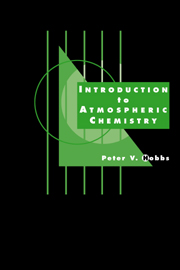Book contents
- Frontmatter
- Contents
- Preface
- 1 Evolution of the Earth's atmosphere
- 2 Half-life, residence time, and renewal time of chemicals in the atmosphere
- 3 Present chemical composition of the atmosphere
- 4 Interactions of solar and terrestrial radiation with atmospheric trace gases and aerosols
- 5 Sources, transformations, transport, and sinks of chemicals in the troposphere
- 6 Atmospheric aerosols
- 7 Cloud and precipitation chemistry
- 8 Tropospheric chemical cycles
- 9 Air pollution
- 10 Stratospheric chemistry
- Appendix I Exercises
- Appendix II Answers to exercises in Appendix I and hints and solutions to the more difficult exercises
- Appendix III Atomic weights
- Appendix IV The International System of Units (SI)
- Appendix V Some useful numerical values
- Appendix VI Suggestions for further reading
- Index
8 - Tropospheric chemical cycles
Published online by Cambridge University Press: 05 June 2012
- Frontmatter
- Contents
- Preface
- 1 Evolution of the Earth's atmosphere
- 2 Half-life, residence time, and renewal time of chemicals in the atmosphere
- 3 Present chemical composition of the atmosphere
- 4 Interactions of solar and terrestrial radiation with atmospheric trace gases and aerosols
- 5 Sources, transformations, transport, and sinks of chemicals in the troposphere
- 6 Atmospheric aerosols
- 7 Cloud and precipitation chemistry
- 8 Tropospheric chemical cycles
- 9 Air pollution
- 10 Stratospheric chemistry
- Appendix I Exercises
- Appendix II Answers to exercises in Appendix I and hints and solutions to the more difficult exercises
- Appendix III Atomic weights
- Appendix IV The International System of Units (SI)
- Appendix V Some useful numerical values
- Appendix VI Suggestions for further reading
- Index
Summary
The reservoirs of chemical species in the Earth system are the solid Earth, the hydrosphere (oceans and fresh water), the cryosphere (ice and snow), the biosphere, and the atmosphere. Chemical species can be transferred between these reservoirs. We have already seen that such transfers played crucial roles in the evolution of Earth's atmosphere. Since, under steady-state conditions, a chemical species cannot accumulate indefinitely in any one of the reservoirs, there must be continual cycling of species through the various reservoirs. This is termed biogeochemical cycling
In this chapter we will consider briefly the tropospheric portions of the biogeochemical cycles of carbon, nitrogen, and sulfur. We have chosen these cycles not only because they are of considerable importance in atmospheric chemistry but because the productivity of many terrestrial and aquatic organisms depends on the availability of these elements (as well as on oxygen and hydrogen). We will be concerned with relatively rapid interchanges involving the atmosphere and other reservoirs (generally the oceans and the biosphere). For simplicity, we will assume the various cycles are independent, although in the atmosphere they can interact with each other and are coupled in the stoichiometry of living matter and biochemical processes. A few words of caution are needed. Many aspects of global chemical cycles are not well understood, and the magnitudes of the various emission fluxes are not necessarily equivalent to the importance of the species, since atmospheric residence times must also be taken into account.
- Type
- Chapter
- Information
- Introduction to Atmospheric Chemistry , pp. 143 - 152Publisher: Cambridge University PressPrint publication year: 2000
- 1
- Cited by



